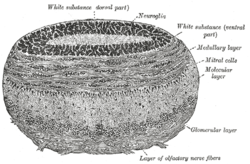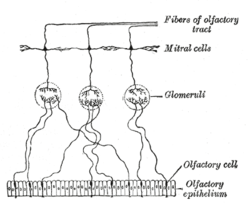Olfactory bulb mitral cell
| Mitral Cell | |
|---|---|

Coronal section of olfactory bulb.
|
|

Plan of olfactory neurons.
|
|
| Identifiers | |
| NeuroLex ID | Mitral Cell |
|
Anatomical terminology
[]
|
|
Mitral cells are neurons that are part of the olfactory system. They are located in the olfactory bulb in the mammalian central nervous system. They receive information from the axons of olfactory receptor neurons, forming synapses in neuropils called glomeruli. Axons of the mitral cells transfer information to a number of areas in the brain, including the piriform cortex, entorhinal cortex, and amygdala. Mitral cells receive excitatory input from olfactory sensory neurons and external tufted cells on their primary dendrites, whereas inhibitory input arises either from granule cells onto their lateral dendrites and soma or from periglomerular cells onto their dendritic tuft. Mitral cells together with tufted cells form an obligatory relay for all olfactory information entering from the olfactory nerve. Mitral cell output is not a passive reflection of their input from the olfactory nerve. In mice, each mitral cell sends a single primary dendrite into a glomerulus receiving input from a population of olfactory sensory neurons expressing identical olfactory receptor proteins, yet the odor responsiveness of the 20-40 mitral cells connected to a single glomerulus (called sister mitral cells) is not identical to the tuning curve of the input cells, and also differs between sister mitral cells. The exact type of processing that mitral cells perform with their inputs still a matter of controversy. One prominent hypothesis is the notion that mitral cells transform the strength of olfactory input into a timing code, where odor concentration is encoded in the phase of mitral cell firing relative to the sniff cycle. A second (not necessarily exclusive) hypothesis is the idea of decorrelation in the olfactory bulb network, where the olfactory bulb network acts as a dynamical system whose action over time increases some (abstract) measure of distance between representations of highly similar odorants. Support for the second hypothesis comes primarily from research in zebrafish (where mitral and tufted cells cannot be distinguished).
...
Wikipedia
